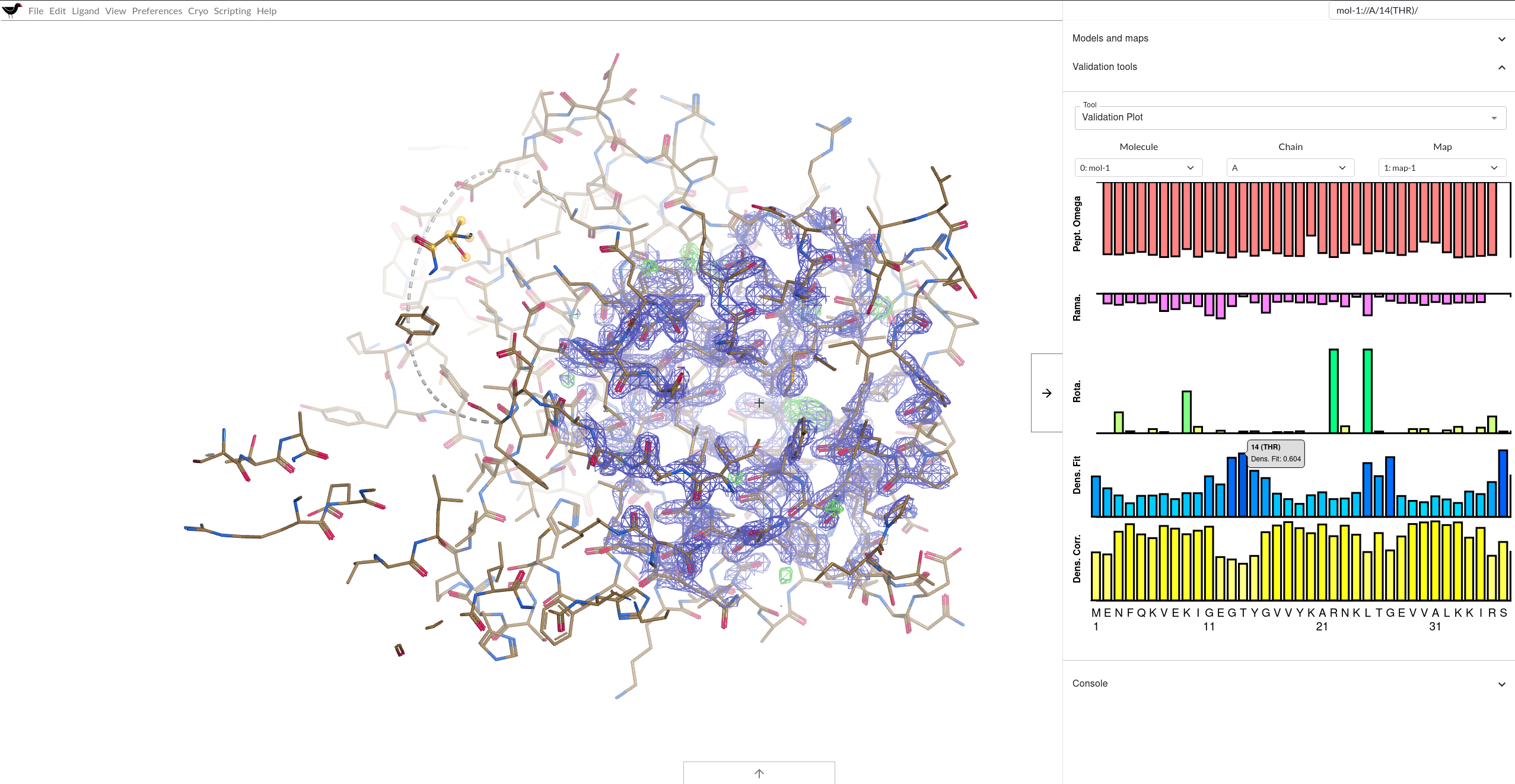Moorhen is a web browser molecular graphics program based on the Coot desktop program. It is developed by porting some CCP4 libraries and programs, Coot, FFTW2, Privateer and the Gnu Scientific Library to Web Assembly.
Also contained are examples of using the generated JS/Web Assembly:
- A command line example which offers some of the functionality of the CCP4 program
superpose. - A command line example which does a structure factor calculation with
clipper.
The emscripten suite of tools is required to do the compilation.
The sources of CCP4, Coot, Privateer, FFTW, and GSL are not included. They are downloaded and (possibly) patched by the running
the get_sources script, which is part of the build process of this project.
The following libraries/programs are compiled to Web Assembly:
- libccp4 (bzr)
- clipper (bzr)
- ssm (bzr)
- mmdb2 (bzr)
- ccp4srs (bzr)
- gemmi 0.5.8
- rvapi (bzr)
- gesamt (bzr)
- ccp4mg (partial) (bzr)
- privateer MKIV
- Coot 1.0 ('gtk3' git branch)
- fftw 2.1.5
- gsl 2.7.1
- Boost 1.80.0
- glm 0.9.9.8
- RDKit 2022_09_2
Binaries are available on the releases page. Please read the instructions there before using.
Moorhen is available to use at https://moorhen.org .
Requirements
- A Bourne-like shell
- bzr
- git
- curl
- patch
- emsdk (Steps 1 and 2 below)
- cmake
- A native C++ compiler. (This is required for part of the
boostbuild system). autoconf,autotoolslibtool
-
Install emscripten (following https://emscripten.org/docs/getting_started/downloads.html):
git clone https://github.com/emscripten-core/emsdk.git
cd emsdk
git pull
./emsdk install latest
./emsdk activate latest -
Each time you want to use emscripten:
source ./emsdk_env.sh -
Get the sources:
git clone https://github.com/stuartjamesmcnicholas/Moorhen.git ccp4_wasm
cd ccp4_wasm
./get_sources -
Build gsl, Boost, RDKIt, Coot, the CCP4 libraries and examples:
In this branch, it is intended that you do the build in the source directory.
After first checkout you should run the following script to build:
./initial_build.sh
This should build all dependencies and thenMoorhen. -
To run the Moorhen molecular graphics application:
cd baby-gru
npm start
And then point a web browser athttp://localhost:3000/.
- When you wish to update the application from this git repository and the
Cootgit repository, do the following steps:git pullcd checkout/coot-1.0git pullcd ../..cd CCP4_WASM_BUILD/moorhen_buildmake install(or e.g.make -j8 installto build on 8 processors).
See example/example.cc or checkout/privateer-MKIV/src/privateer.cpp to see how to create a command line (node) program. The
latter is quite long and a patched version of the original privateer code. It might be more helpful to look at the patch file
patches/privateer-emscripten.patch. This should show how to patch an existing command line program which reads files to one
that will work within node.
See coot/moorhen-wrappers.cc to see use of EMSCRIPTEN_BINDINGS to expose Coot methods to the web browser.
Any program you write, which uses the subset of Coot, Clipper, Privateer code which this project compiles to WASM, can
itself be compiled to WASM and used within node or Web Browser. Studying the examples should show you to do I/O, which is
different in the 2 cases. If you require more classes or methods from the libraries to be exposed to JavaScript, then changes need to be made to
coot/moorhen-wrappers.cc. This should only be necessary for browser usage - in node your whole program can be written in C++.
- Emscripten
- Coot
- P. Emsley; B. Lohkamp; W.G. Scott; Cowtan (2010). Features and Development of Coot, Acta Crystallographica. D66 (4) p486–501.
- Privateer
- Agirre, J., Iglesias-Fernández, J., Rovira, C., Davies, G.J., Wilson, K.S. and Cowtan, K.D., (2015), Privateer: software for the conformational validation of carbohydrate structures, Nature Structural and Molecular Biology 22(11), p.833.
- Bagdonas, H., Ungar, D. and Agirre, J., (2020), Leveraging glycomics data in glycoprotein 3D structure validation with Privateer, Beilstein Journal of Organic Chemistry, 16(1), p2523-2533.
- Clipper
- Cowtan K (2003), The Clipper C++ libraries for X‐ray crystallography, IUCr Comput Comm Newslett 2, p4–9
- CCP4
- Winn MD, Ballard CC, Cowtan KD, Dodson EJ, Emsley P, Evans PR, Keegan RM, Krissinel EB, Leslie AGW, McCoy A, McNicholas SJ, Murshudov GN, Pannu NS, Potterton EA, Powell HR, Read RJ, Vagin A, Wilson KS (2011), Overview of the CCP4 suite and current developments, Acta Cryst D67, p235–242.
- Gemmi
- Gesamt
- Krissinel E. (2012), Enhanced fold recognition using efficient short fragment clustering, Journal of molecular biochemistry, 1(2), p76–85.
- ProSMART
- R.A. Nicholls, M. Fischer, S. McNicholas and G.N. Murshudov (2014) Conformation-Independent Structural Comparison of Macromolecules with ProSMART. Acta Cryst. D70, p2487-2499.
- GSL
- M. Galassi et al, GNU Scientific Library Reference Manual (3rd Ed.), ISBN 0954612078
- https://www.gnu.org/software/gsl/
- FFTW
- Frigo, Matteo and Johnson, Steven G. (2005), The Design and Implementation of FFTW3, Proceedings of the IEEE 93(2), p216-231.
- RDKit
- RDKit: Open-source cheminformatics https://www.rdkit.org
- Boost
- Boost C++ libraries https://www.boost.org/users/license.html
- GLM
- Open GL Mathematics https://github.com/g-truc/glm
